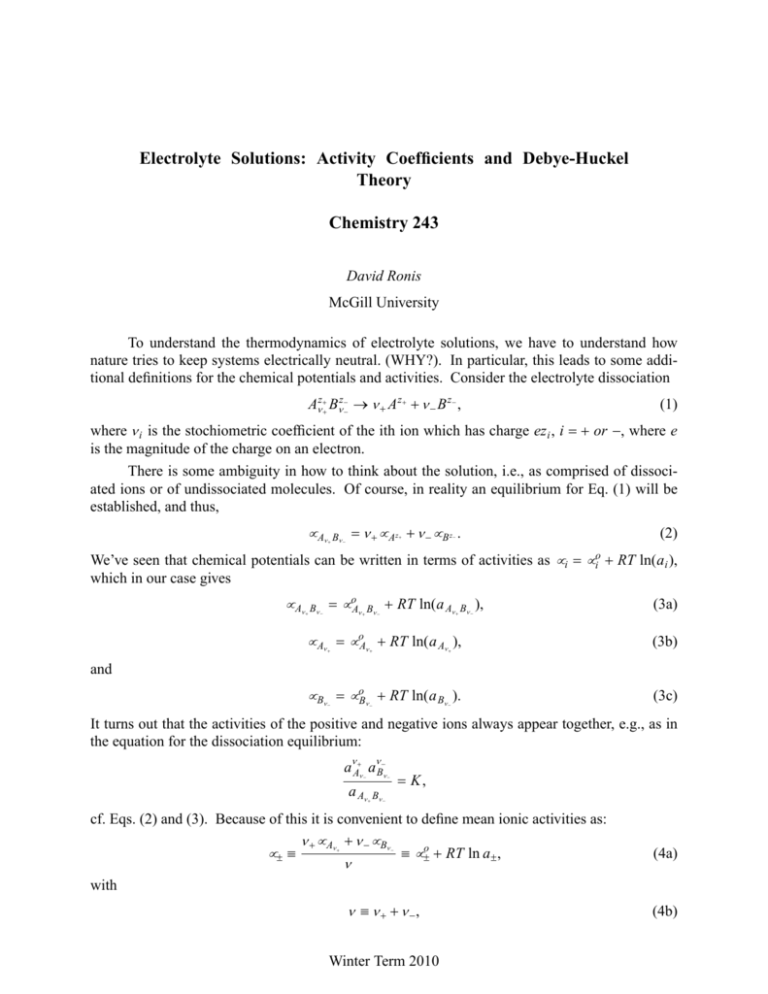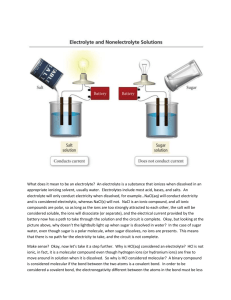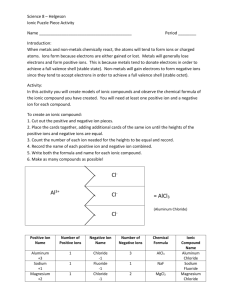Electrolyte Solutions: Activity Coefficients and Debye
advertisement

Electrolyte Solutions: Activity Coefficients and Debye-Huckel Theory Chemistry 243 David Ronis McGill University To understand the thermodynamics of electrolyte solutions, we have to understand how nature tries to keep systems electrically neutral. (WHY?). In particular, this leads to some additional definitions for the chemical potentials and activities. Consider the electrolyte dissociation Aνz++ Bνz−− → ν + A z+ + ν − B z− , (1) where ν i is the stochiometric coefficient of the ith ion which has charge ez i , i = + or −, where e is the magnitude of the charge on an electron. There is some ambiguity in how to think about the solution, i.e., as comprised of dissociated ions or of undissociated molecules. Of course, in reality an equilibrium for Eq. (1) will be established, and thus, µ Aν + = ν + µ Az + ν − µ B z . Bν − + − (2) We’ve seen that chemical potentials can be written in terms of activities as µ i = µ io + RT ln(ai ), which in our case gives µ Aν + Bν − = µ oAν + Bν − + RT ln(a Aν + Bν − ), (3a) µ Aν = µ oAν + RT ln(a Aν ), (3b) µ Bν = µ oBν + RT ln(a Bν ). (3c) + + + and − − − It turns out that the activities of the positive and negative ions always appear together, e.g., as in the equation for the dissociation equilibrium: aνA+ν aνB−ν − a Aν = K, − B + ν− cf. Eqs. (2) and (3). Because of this it is convenient to define mean ionic activities as: ν + µ Aν + ν − µ Bν µ± ≡ ≡ µ ±o + RT ln a± , + − ν (4a) ν ≡ ν + + ν −, (4b) with Winter Term 2010 Activities & Debye-Huckel Theory -2- Chemistry 243 ν µ ±o ≡ ν + µ oAν + ν − µ oBν , (4c) ν ν aν± ≡ a A+ν a B−ν . (4d) + − and + − Hence, the dissociation equilibrium becomes: aν± a Aν + = K. Bν − Finally, if we define a mean mole fraction as xν± ≡ xν++ xν−− it follows from Eq. (4d) that the mean activity coefficient is given by γ ±ν ≡ γ +ν + γ −ν − . We next consider a model for the activities of dilute electrolyte solutions. Since the undissociated molecule is neutral, ν + z + + ν − z − = 0. If ρ i is the concentration of the ith ion, then the fact that we start with a electrically neutral compound implies that Σi ρ i ezi = 0. (5) Does electro-neutrality hold locally; i.e., very near to one of the ions? Consider a statistical model for the local charge density. Based on our work on the kinetic theory of gases, we know that Probability∝ exp(−Energy/k B T ), (6) and for electrical problems it is reasonable to assume that Energy = ez i φ (r) (7) where φ (r) is the electrical potential around one of the ions in the solution, here assumed to be at the origin of our coordinate system. Using these probabilities to moderate the local density, we see that local charge density, σ (r) is σ (r) = Σi ρ i ezi exp(−ezi φ (r)/k B T ) (8) For a positive ion at the origin, we expect that φ (r) > 0 and hence, Eq. (8) predicts a net excess negative charge density in the local vicinity of our ion. This is the physical basis of the phenomena of screening. If the electrostatic energies are small compared with thermal energies, i.e., eφ (r) << k B T , we can use the well known approximation for the exponential, x 2 ... e ≈1+ x+ + , 2 (9) 2Ie2 σ (r) ≈ − φ (r) + ..., k BT (10) x in Eq. (8) to show that where I≡ 1 ρ i z 2i 2Σ i (11) is called the ionic strength and has units of concentration (indeed, for 1-1 electrolytes it is simply the concentration in molecules per unit volume). In obtaining Eq. (10) overall electro-neutrality, Winter Term 2010 Activities & Debye-Huckel Theory -3- Chemistry 243 cf. Eq. (5), was used to eliminate the leading order terms. How much charge will be induced by having an ion (with charge Q) at the origin? Gauss’s law strongly suggests that the induced charge, cf. Eqs. (8) or (10), exactly balance the charge at the origin; i.e., local electro-neutrality will hold, and thus, Q=− ∫ dr σ (r) = −4π ∞ ∫0 dr r 2σ (r) ≈ 2Ie2 ∞ dr r 2φ (r) k BT 0 ∫ (12) where the second to last equality follows by switching to polar coordinates, and the final one by using Eq. (10). In the absence of screening, the potential is simply Coulomb’s law; namely, Q φ (r) = , (13) 4π ε r where ε is the electric permittivity of the solvent. How will this change if the charge is screened? To answer this requires some physics that is a bit beyond this course* and instead we’ll simply guess the form of the screened potential, i.e., Q φ (r) = e−κ D r , (14) 4π ε r where the exponential accounts for the screening and κ D is known as the Debye screening wavevector. The screening sets in on a length scale of λ D = 1/κ D . What is the screening length? To answer this we’ll impose local electro-neutrality, cf. the last equality in Eq. (12); hence, Q= 2Ie2 Q 1 2Ie2 Q ∞ dr re−κ D r = . ε k BT 0 ε k B T κ D2 ∫ (15) Thus, by solving for κ D , we see that κD = √ √ 2e2 I = ε k BT 2F 2 I , ε RT (16) where the second equality is obtained when the ionic strength and electron charge are expressed as mol/m 3 and the Faraday, F, respectively. For a 1:1 electrolyte in water at 25C, this gives a screening length of λD = 1 κD = o 3. 04 (in A), 1/2 c where c is the molar salt concentration; hence, the counter-ion cloud around any given ion in a o o 0.01M salt solution is about 50 A in radius (λ D = 30. 4A, but the cloud extends beyond λ D somewhat). * Specifically, as you will see in PHYS 242, you need to know Poisson’s equation for the electric potential due to a charge distribution in a dielectric medium; i.e., ∇2φ (r) = −σ (r)/ε . When Eq. (8) is used for the charge density, we obtain what is known as the nonlinear PoissonBoltzmann equation, which cannot be solved analytically for all but 1-dimensional problems. When Eq. (10) is used the linearized Poisson-Boltzmann or Debye-Huckel equation is obtained; this can be solved in closed form and gives the result presented in the text. Winter Term 2010 Activities & Debye-Huckel Theory -4- Chemistry 243 How much work was done on the system in placing the ion and the screening ions at the origin? Clearly, W = ∫ dr φ (r)σ (r) = 4π ∞ ∫0 dr r 2φ (r)σ (r) = − 8π Ie2 ∞ κ Q2 dr r 2φ 2 (r) = − D , 8π ε k BT 0 ∫ (17) where we’ve again switched to polar coordinates and used Eqs. (10), (14), and (16). Thus, for a mole of either of the ions, the work is just done is N Aκ D e2 z 2i − . 8π ε Of course, this is just another contribution to the non-PV work or chemical potential associated with dissolving the ith ionic species. Hence, RT ln γ i = − N Aκ D e2 z 2i 8π ε (18a) or ln γ i = − κ D e2 z 2i =− 8π k B T ε κ D F 2 z 2i 8π N A RT ε . (18b) This is known as the Debye-Huckel limiting law and is valid at low concentrations (typically, it breaks down in the 0.005 to 0.01 M range). Note that the sign of the ionic charge is irrelevant and that ln γ i ∝I 1/2 . With Eq. (18) it is easy to work out the mean activity coefficient; specifically, ln γ ± = − = κ D e2 (ν + z 2+ + ν − z 2− ) 8π k B T ε ν κ D e2 8π k B T ε , z+ z−, where the second relation follows by noting that the undissociated molecule is neutral. Winter Term 2010 (19a) (19b)






